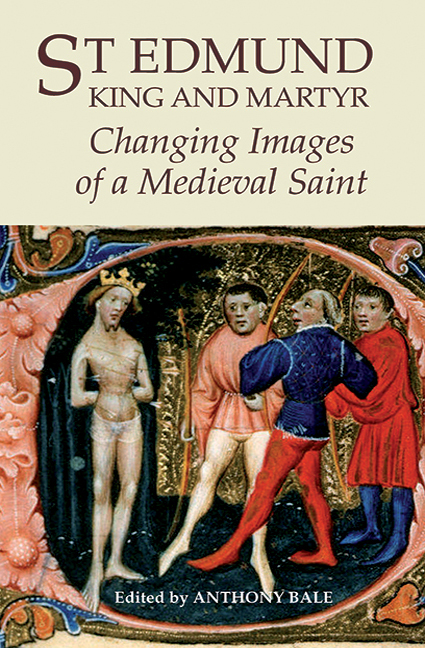Book contents
- Frontmatter
- Contents
- Preface
- List of Contributors
- List of Abbreviations
- Introduction: St Edmund's Medieval Lives
- 1 King, Martyr and Virgin: Imitatio Christi in Ælfric's Life of St Edmund
- 2 Chronology, Genealogy and Conversion: The Afterlife of St Edmund in the North
- 3 Geoffrey of Wells’ Liber de infantia sancti Edmundi and the ‘Anarchy’ of King Stephen's Reign
- 4 Music and Identity in Medieval Bury St Edmunds
- 5 Medieval images of St Edmund in Norfolk Churches
- 6 John Lydgate's Lives of Ss Edmund and Fremund: Politics, Hagiography and Literature
- 7 St Edmund in Fifteenth-Century London: The Lydgatian Miracles of St Edmund
- 8 The Later Lives of St Edmund: John Lydgate to John Stow
- Select Bibliography
- Index
- Miscellaneous Endmatter
Preface
Published online by Cambridge University Press: 11 May 2017
- Frontmatter
- Contents
- Preface
- List of Contributors
- List of Abbreviations
- Introduction: St Edmund's Medieval Lives
- 1 King, Martyr and Virgin: Imitatio Christi in Ælfric's Life of St Edmund
- 2 Chronology, Genealogy and Conversion: The Afterlife of St Edmund in the North
- 3 Geoffrey of Wells’ Liber de infantia sancti Edmundi and the ‘Anarchy’ of King Stephen's Reign
- 4 Music and Identity in Medieval Bury St Edmunds
- 5 Medieval images of St Edmund in Norfolk Churches
- 6 John Lydgate's Lives of Ss Edmund and Fremund: Politics, Hagiography and Literature
- 7 St Edmund in Fifteenth-Century London: The Lydgatian Miracles of St Edmund
- 8 The Later Lives of St Edmund: John Lydgate to John Stow
- Select Bibliography
- Index
- Miscellaneous Endmatter
Summary
The essays in this volume stem from a very productive and rewarding public seminar held at Birkbeck College, University of London, in 2004. The seminar, entitled St Edmund: Royalty, Martyrdom, Masculinity, was sponsored by Birkbeck's School of English and Humanities but was not just focused on literary texts. The seminar brought together an exciting and diverse range of disciplines: Old and Middle English studies, Scandinavian studies, music, art history, histories of gender and sexuality, book history, theology, political history. The audience, comprising scholars, students and members of the public, likewise attested to the appeal and relevance of the saint and to the ongoing blossoming of ‘medieval studies’, broadly conceived. The essays assembled here contribute a range of readings of St Edmund's cult, from different disciplines, and also offer a kind of history of St Edmund's cult in its many different facets, from the ninth century to the early modern period.
The time-frame of this collection covers the chronological span of Edmund's medieval cult, from the murky circumstances of the saint's death and his first vita, written between 985 and 987 by Abbo of Fleury, to a life of the saint written in newly Protestant sixteenth-century England. This collection is not, however, intended to provide an exhaustive account of the cult of St Edmund; given the enormous range and reach of the cult, such would be an over-ambitious undertaking. Rather, the guiding principle to these essays is the rewritings, continuities and reconceptualisations of sanctity represented in Edmund's changing saintly image. In this way, the intention of the volume is to show the openness and dynamism of a medieval saint's cult, to demonstrate how the saint's image could be used in many and changing contexts. Edmund's image was bent to various political and propagandistic ends, negotiating identity, politics and belief. While Edmund's iconographic attributes generally remain constant – crowned or shot through with arrows – this stability belies a variety of rewritings of his life and a steady accretion of traditions and apocrypha. When we think of medieval people being devoted to a saint, we need to prompt ourselves to ask what it is that people were devoted to; the substance of devotion is not necessarily fixed or stable, and it is not easily retrievable.
- Type
- Chapter
- Information
- St Edmund, King and MartyrChanging Images of a Medieval Saint, pp. vii - viiiPublisher: Boydell & BrewerPrint publication year: 2009

